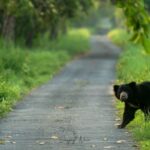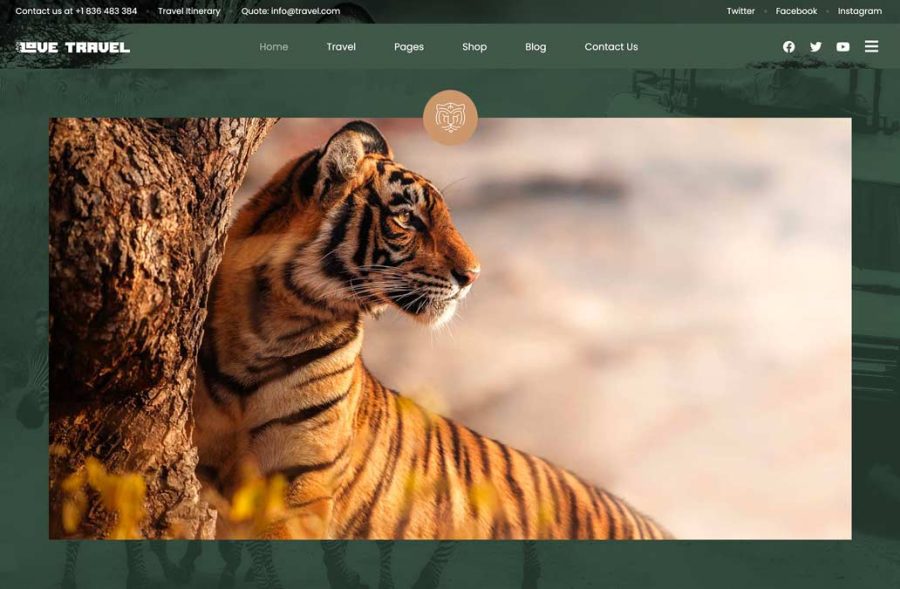We have all been enthralled with national geographic documentaries at some point. But have you seen the best of them featuring Indian wildlife?
India, a land of staggering diversity, is a treasure trove of life. Beneath the shadow of snow-capped Himalayas, along the sultry mangroves of the Sundarbans, or across the searing deserts of Rajasthan, there thrives an astonishing array of species.
From the majestic tiger to the diminutive dhole, each creature plays its role in nature’s grand performance.
In this article, we dive deep into five National Geographic documentaries that unveil these stories with stunning visuals, poignant narratives, and the unmistakable allure of the wild.
Jump To
Toggle1. Wild India: A Tapestry of Life
Imagine a world where the elements collide, forging habitats as varied as the creatures that inhabit them. Wild India is an ode to these lands—a cinematic journey through the snow-dusted Himalayan peaks, the muggy Sundarbans, the windswept Thar Desert, and everything in between.
Key Highlights:
- The Himalayan Kingdom: Witness red pandas playing in the misty foothills and snow leopards, the ghostly hunters of the peaks, stealthily stalking their prey.
- The Sundarbans: Here, the mighty Bengal tiger becomes amphibious, navigating mangrove labyrinths as it swims between islands in pursuit of spotted deer.
- The Thar Desert: Defying expectations, the desert is alive with creatures like the blackbuck and the resilient desert fox.
Why It’s Special
The narration by Sir David Attenborough breathes life into each scene. His voice carries you from the rustling leaves of the Western Ghats to the sun-scorched sands of Rajasthan. The cinematography is breathtaking—every frame is a painting, every sound a melody of life.
Best Places to See these animals in India
- Snow Leopards: Hemis National Park in Ladakh offers the best chance to spot these elusive cats.
- Bengal Tigers: Visit Sundarbans National Park in West Bengal to see tigers adapted to a mangrove habitat.
- Asiatic Lions: Gir National Park in Gujarat is the only place where Asiatic lions still roam.
2. Wild Dog Diaries: The Unsung Heroes of Bandipur
If wildlife documentaries were sports, tigers would take gold, and dholes—India’s wild dogs—would play the underdogs, pun intended. But these fiery-coated canines, featured in Wild Dog Diaries, are anything but secondary players.
Key Highlights:
- Pack Dynamics: Packs of dholes operate with military precision, communicating through whistles, grunts, and barks as they herd their prey into ambush zones.
- Epic Hunts: Unlike solitary hunters, dholes tackle prey much larger than themselves—gaur (Indian bison) and deer stand little chance against their collective strategy.
- Unbreakable Bonds: From playful pups wrestling with elders to adults mourning their dead, the film showcases the emotional intelligence of these remarkable creatures.
Why It’s Special:
The film, directed by Senani Hegde, gets so close to its subjects that you feel part of the pack. You’ll hold your breath during heart-pounding chases and chuckle at pups tumbling over each other in bouts of mischief. This is the dogged determination of survival, set against the backdrop of Bandipur’s misty forests.
Best Places to See Dholes
- Bandipur National Park in Karnataka is famous for dhole sightings, especially during the dry season when packs hunt near waterholes.
- Nagzira Wildlife Sanctuary, Maharashtra, is another excellent location where these social predators thrive amidst its dense deciduous forests. Sightings are frequent, including some of the biggest packs we’ve seen personally.
3. Tiger Sisters of Telia: Sibling Rivalry on Steroids
Sibling drama isn’t just a human trait—it’s alive and clawing in Tadoba Andhari Tiger Reserve. Tiger Sisters of Telia takes us into the lives of four tigresses—Mona, Geeta, Lara, and Sonam—who’ve defied solitary norms to share territory and, sometimes, prey.
Key Highlights:
- Rare Footage: Tigers are loners, but these sisters hunt cooperatively, defend their lake territory, and even tolerate each other’s cubs.
- High-Stakes Drama: Watch as a rival male prowls into their domain, sparking tensions that could turn fatal.
- Motherhood Chronicles: The film dives into how the sisters nurture their cubs, teaching them to hunt and defend themselves in the unforgiving wilderness.
Why It’s Special:
This documentary breaks stereotypes about tigers and their social behavior. The sisters’ dynamic is a beautiful paradox—unity amid competition, love tempered by the primal need to survive. You’ll cheer, gasp, and maybe even cry as these apex predators navigate their wild lives.
Best Place to See Tigers
- Tadoba Andhari Tiger Reserve, Maharashtra, offers a high chance of spotting tigers, including the lineage of the famed tiger sisters.
4. Battling India’s Illegal Tiger Trade: One of the Best National Geographic documentaries
While we marvel at tigers on screen, there’s a grim reality lurking in the shadows. Every day, India’s tigers are hunted—not by predators, but by humans. Battling India’s Illegal Tiger Trade is a raw, unflinching dive into the brutal world of poaching and illegal wildlife trafficking.
Key Highlights:
- Undercover Operations: Cameras follow conservationists and anti-poaching teams as they infiltrate black markets, where tiger parts are sold at exorbitant prices.
- The Rangers’ Fight: Armed with basic equipment, forest guards risk their lives to patrol reserves, ensuring these apex predators remain safe.
- Demand vs. Destruction: The documentary sheds light on how superstition and greed fuel the market for tiger bones, pelts, and claws in regions across Asia.
Why It’s Special:
This isn’t just a film—it’s a call to action. Poaching is exposed not as a faceless crime but as a web of human greed, ignorance, and exploitation. Yet, it offers hope: through efforts to dismantle trafficking rings and the resilience of those who risk everything to save the tiger.
Best Places to Witness Anti-Poaching Efforts
- Ranthambore National Park, Rajasthan, where rangers and NGOs actively combat poaching, is also one of the best places to see Bengal tigers.
- Sariska Tiger Reserve, Rajasthan – Sariska is a tiger conservation story of resilience. After losing all its tigers to poaching in 2004, it became the site of India’s first tiger reintroduction program in 2008. Today, the reserve hosts a growing population of tigers, supported by robust monitoring and habitat restoration, making it a symbol of hope for wildlife recovery.
5. India’s Wild Leopards: Stealth in the Shadows
While tigers roar in the limelight, leopards slink in the shadows, quietly reigning as one of India’s most adaptable big cats. India’s Wild Leopards unravels the secret lives of these spotted phantoms, from remote jungles to city outskirts.
Key Highlights:
- Urban Predators: Leopards have mastered living alongside humans, often prowling near villages and farms under the cover of darkness.
- Conflict and Coexistence: The film addresses the complex relationship between humans and leopards, where fear and reverence intertwine.
- A Solitary Life: Unlike lions or wolves, leopards live solitary lives. Yet, the film captures rare moments of maternal care and sibling play.
Why this is one of the best national geographic documentaries:
The documentary shifts focus from the grandeur of wilderness to the periphery of human settlements, where leopards walk the tightrope of survival. It’s an intimate portrayal of a cat that’s as misunderstood as it is magnificent.
Best Places to See Leopards
- Jawai Leopard Conservation Reserve in Rajasthan offers a rare chance to see leopards in rocky terrain, coexisting with the Rabari shepherds.
- Nagzira Tiger Reserve Maharashtra, provides an excellent opportunity to spot leopards in its pristine forests. It is particularly noted for its leopard population that thrives alongside other large predators.
6. The Real Black Panther: A Creature of Mystery
The Real Black Panther transports you to the enchanting forests of Kabini in Karnataka, where one of nature’s rarest wonders resides—a melanistic leopard named Saya. This documentary is not just about the black panther; it’s about perseverance, adaptation, and survival in a world that’s anything but forgiving. The film follows the work of renowned wildlife photographer and cinematographer Shaaz Jung, whose lens brings Saya’s mysterious life into vivid focus.
Key Highlights
- A Rare Phenomenon: Saya’s glossy black coat is a result of melanism, a genetic condition that gives him a shadowy appearance, allowing him to blend seamlessly into Kabini’s dense undergrowth.
- Rivals in the Jungle: The story unfolds as Saya challenges traditional hierarchies, facing dominant golden leopards and even tigers, asserting himself in a competitive ecosystem.
- Shaaz Jung’s Vision: The documentary owes much to Shaaz Jung’s dedication, who spent years tracking Saya, capturing his behavior and unveiling the secret life of this enigmatic predator.
Why it’s special
The film boasts unprecedented footage of a black panther navigating its domain—stalking prey, marking territory, and resting in the shadows, showcasing its stealth and elegance.
Best Place to See Black Panthers in India
- Kabini Wildlife Sanctuary, Karnataka, is the crown jewel for melanistic leopard sightings. Known as “the Land of Leopards,” it offers visitors a chance to spot not only Saya but also golden leopards, elephants, and a host of other wildlife.
- Tadoba Andhari Tiger Reserve, Maharashtra, is another emerging hotspot where lucky visitors have reported sightings of melanistic leopards.
- Pench Tiger Reserve, straddling Maharashtra and Madhya Pradesh, has occasionally treated visitors to glimpses of black panthers along its lush forested trails.
Conclusion: A Journey into India’s Untamed Heart
India’s wilderness is a living, breathing testament to the intricate web of life. Through the lens of National Geographic, we’ve explored stories of resilience, survival, and sheer wonder—from the haunting call of the black panther in Kabini to the synchronized hunts of dholes in Bandipur, from the sibling drama of the Telia tigers to the inspiring conservation tales of Kaziranga and Sariska.
These documentaries do more than just entertain; they remind us of our shared responsibility to protect the natural world. They take us into the lives of creatures struggling against the odds, thriving in some of the most challenging environments, and coexisting with humans in ways that inspire awe and reflection.
To venture into these sanctuaries, either through a screen or on the ground, is to step into a world where the laws of nature reign supreme, and every shadow hides a story waiting to be told. Whether you’re a wildlife enthusiast, a conservationist, or simply curious, these films offer a window into India’s wild soul—a glimpse of what we stand to lose and why it’s worth saving.
As the sun sets on these untamed landscapes, one thing becomes clear: the wild calls to us all. Will you answer? 🌿
From the majestic tiger to the diminutive dhole, each creature plays its role in nature’s grand performance.
In this article, we dive deep into five National Geographic documentaries that unveil these stories with stunning visuals, poignant narratives, and the unmistakable allure of the wild.

























